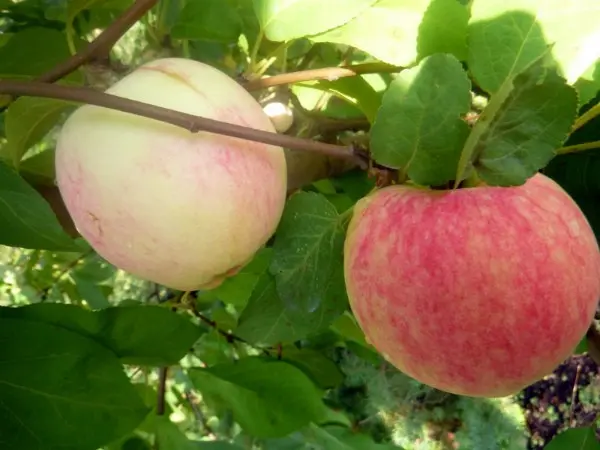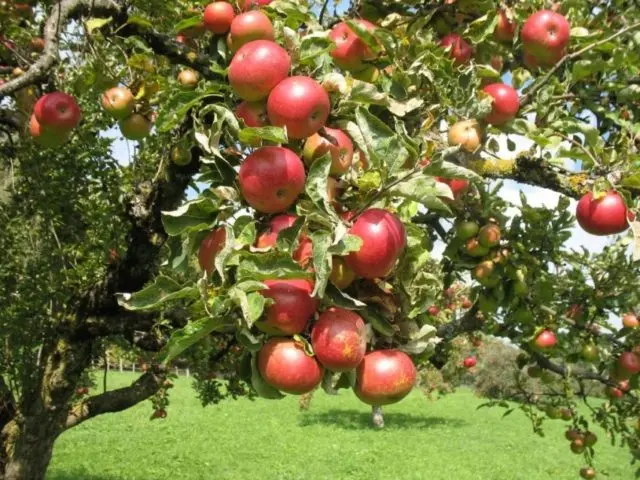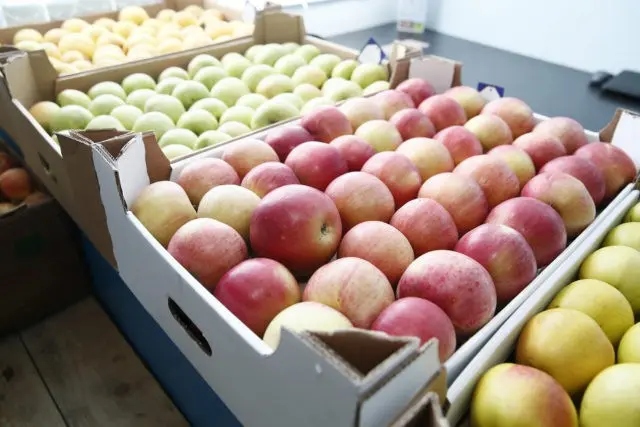Contents
Among apple varieties there are those that are known to almost every gardener. One of them is the Kitayka Bellefleur apple tree. This is an old variety, which used to be often found in the gardens of the regions of the Middle Strip. It has become popular due to the simple cultivation techniques and good quality fruits.
Description of the variety of apples Kitayka Bellefleur with a photo
The description and characteristics of the Chinese Bellefleur variety will help gardeners understand what an apple tree and its fruits look like, what they taste like. Information about this is necessary in order to decide whether to choose a tree for growing in your garden or not.
History of breeding
The author of Belfleur-Chinese is the world-famous breeder I. V. Michurin, breeding work was carried out in 1908-1921. Parental forms are the American variety Belfleur yellow and Kitayka large-fruited. Introduced into the State Register in 1947, zoned for the North Caucasus region.
Appearance of fruit and tree
The Belfleur Chinese apple tree is tall, powerful. Dense rounded or broadly rounded crown. The bark is brown, with a reddish tint, the leaves are dark green with a grayish tinge. The apple tree bears fruit on fruit twigs and last year’s growths. The fruits are above average or large in size, the average weight is 190 g (maximum 500-600 g). Apples are round and oval-round, with a ribbed surface. Funnel without rust. The peel of the fruit is light yellow, on one side there is a striped and speckled blush.
The Chinese Bellefleur apple tree on a semi-dwarf rootstock has a height of about 3 m, which makes it easier to care for the tree and harvest. More plants can be placed per unit area, the total amount of the harvested crop will be higher. The fruits ripen 2 weeks earlier.

Ripe fruits Bellefleur Kitaika look like an early Shtrifel
Life time
The maximum age of an apple tree as a species can reach 100 years, but in practice such specimens are rare. Most fruit trees live 50-60 years, fruiting time – 20-40 years.
Taste
Bellefleur fruits Chinese dessert purpose, their flesh is fine-grained, white, juicy. The taste was noted by tasters as very good, sour-sweet, vinous, with spicy notes, aroma is present.
Productivity
The productivity of the Bellefleur Chinese apple tree is good, the young tree bears fruit annually, with age there is a periodicity. It also depends on the growing region, more fruits are harvested in the south, less in the Middle lane. In general, from 1 sq. m. of the area occupied by an apple tree, you can collect 15-20 kg of fruit.
Frost resistance
Winter hardiness is average. In the Middle lane and the northern regions, the apple tree can freeze out in frosty winters, and in damp winters it can be affected by a fungus.
Disease and pest resistance
The variety is resistant to scab, leaf damage is medium, fruits are severe. Rot resistance is good.
Flowering period
The Belfleur Chinese apple tree blooms in late April or May. Flowering, depending on the weather, lasts about 1-1,5 weeks.
When to pick Kitayka Bellefleur apples
Fruit ripening time – the second half of September. Fruiting is plentiful. Fruits after ripening usually do not crumble, keep well on the branches. It is recommended to keep them for 2-3 weeks before use. During storage, the skin of Chinese Bellefleur apples turns white.
Pollinators
The variety is self-fertile, does not need pollinators. According to breeders, he can be a good pollinator.
Transportation and storage
The transportability of fruits is high, they can be transported for laying in storage or for sale. Apples are stored for a short time – only 1-1,5 months.
Features of cultivation in the regions
Belfleur Kitaika, when bred, was intended for cultivation in the Middle lane and southern regions. In the Federation, the variety is distributed in the Central Black Earth Region, the North Caucasus, and the Lower Volga region. Apple trees are also grown in Ukraine, Belarus, Armenia. Usually they are found in private gardens, they are used for industrial cultivation in the North Caucasus.
In the southern regions, the variety is considered late summer, its fruits ripen at the end of summer, in the Middle lane – autumn, as apples ripen at the end of September.
Advantages and disadvantages
The Bellefleur Kitayka variety has both advantages and disadvantages. The main advantage is the commercial and consumer qualities of apples, the use of the variety for breeding new varieties of crops, and high drought resistance.
Disadvantages: tall stature, low early fertility (begins to bear fruit late, at 6-8 years of age), susceptibility to scab.

Ripe apples do not fall off the branches; they remain whole and not damaged before picking.
Planting and care
Bellefleur saplings Chinese take out to the site in spring or autumn. The preparation of the plant and the sequence of work are standard: the dried ends of the roots are cut off from the apple tree, the roots are lowered into the solution of the root formation stimulator for 1 day.
For planting, you need to choose a warm spring or autumn day. First, it is important to prepare a planting hole with a size of at least 0,5 by 0,5 m. If the root system of the seedling is larger, then the hole must be made wider and deeper. At the bottom put a drainage layer of broken bricks, slate, small stones. From above, pour a layer of fertile soil mixture consisting of excavated earth and humus (50 to 50), add 1-2 kg of wood ash. To mix everything.
Landing sequence:
- Place a seedling in the middle of the hole.
- Spread the roots so that they diverge freely in all directions.
- Cover with earth.
- Pour water over when it is absorbed, lay a layer of mulching material on top, for example, straw, old hay, sawdust.
- Put a peg next to it, tie a trunk to it. This is necessary so that the plant grows straight until it takes root.
Apple tree care includes watering, fertilizing, pruning and spraying from diseases and pests. The frequency of watering in the first month after planting is about 1 time per week, but may be more or less, depending on the weather. It is necessary to ensure that the soil always remains moist, not dry, but not damp. When the Chinese Bellefleur tree takes root (after 1,5 months), it will be enough to water it several times during the season when the earth dries up.
The first top dressing of the apple tree is carried out in the 2nd year after planting, in the spring after the snow melts. Humus is introduced into the trunk circle in the amount of 1,5 buckets per plant and 1-2 kg of ash. Adult fruiting apple trees need to be fertilized at least 2 more times per season – after flowering and in the middle of the fruit formation period. You can use complex mineral fertilizers or organics.
The first pruning is carried out the next spring after planting. The tree shortens the central and lateral shoots, this stimulates the growth of new branches. In the future, pruning is carried out once a year, in the fall after leaf fall or in the spring before the buds swell. Remove all shrunken, frozen and damaged branches, extra shoots that grow inward and thicken the crown.
The incidence of scab can be prevented by preventive treatments with Bordeaux mixture, fungicides, and mandatory pruning. If the disease has appeared, it must be treated. Of the pests on the Chinese Bellefleur apple tree, aphids, spider mites, flower beetles, codling moths, and sawflies can attack. Control measures – spraying with insecticide solutions at the first sign of the appearance of insects.
Collection and storage
Gather apples Kitayki Bellefleur in September. The fruits do not crumble, which allows them to be picked intact directly from the branches. Apples are stored in a cellar or basement at a temperature of 0 to 10 ˚С and humidity up to 70%. It is advisable to place them separately from vegetables and other fruits so that they do not lose their flavor. In the cold, apples can lie until December at most.

It is advisable to store apples in shallow boxes, stacked in one layer.
Conclusion
Apple tree Kitayka Bellefleur is an old variety that has not lost its attractiveness for modern gardeners. Despite its shortcomings, it is still popular due to the high quality of its fruits. In a private garden, you can plant an apple tree of this variety on a semi-dwarf rootstock, it has all the valuable characteristics inherent in the variety, but it does not grow as tall.









